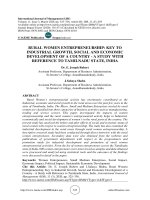Economic growth and economic development 578
Bạn đang xem bản rút gọn của tài liệu. Xem và tải ngay bản đầy đủ của tài liệu tại đây (87.01 KB, 1 trang )
Introduction to Modern Economic Growth
is independent of the others. Imagine that the individual invests an amount x/N in
each of N projects. The Strong Law of Large Numbers implies that as N → ∞, a
fraction p of these projects will be successful and the remaining fraction 1 − p will
be unsuccessful. Therefore, the individual will receive (almost surely) a utility of
u (y + (p (1 + R) − 1) x) .
Since 1 + R > 1/p, this is strictly increasing in x, and implies that the individual
would prefer to invest all of its endowment in the risky projects, i.e., x = y. Therefore, the ability to hold a balanced portfolio of projects with independently disputed
returns allows the individual to diversify the risks and act in a risk-neutral manner.
A similar logic will apply in many of the models we will study in the next three chapters; even though individual firms will have stochastic returns, the representative
household will hold a balanced portfolio of all the firms in the economy and thus will
have risk-neutral preferences in the aggregate. This will imply that the objective of
each firm will be to maximize expected profits (without a risk premium).
12.6. Taking Stock
This chapter has reviewed a number of conceptual and modeling issues related
to the economics of research and development. We have introduced the distinction
between process and product innovations, macro and micro innovations, and also
discussed the concept of innovation possibilities frontier and the importance of the
non—rivalry of ideas.
We have also seen why ex post monopoly power is important to create incentives for research spending, how incentives to undertake innovations differ between
competitive firms and monopolies, and how these compare to the social value of
innovation. In this context, we have emphasized the importance of the appropriability effect, which implies that private value of innovation often falls short of the
social value of innovation, because even with ex post monopoly power an innovating
firm will not be able to appropriate the entire consumer surplus created by a better
product or a cheaper process. We have also encountered the famous replacement
effect, which implies that unless they have a cost advantage, incumbent monopolists
will have weaker incentives to undertake research to improve their products than
564









